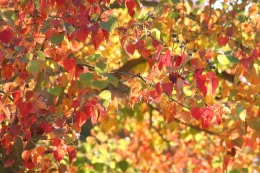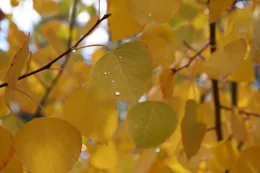Autumn Jewels

Why do some trees change color and drop their leaves before winter? And why are there different colors?
Leaves are colored by pigment molecules. Most leaves appear green because they contain an abundance of the pigment chlorophyll. Chlorophyll is the site of photosynthesis where the sun's energy is converted into the carbohydrates that are plants' food source. During the cold winter months when there is less sunlight, it would take too much energy for some trees to keep their leaves healthy. So deciduous trees lose their leaves for the winter. Evergreen trees have a different strategy for dealing with winter's challenges (which is a topic for another time!).


Elevation, latitude and weather all affect the timing and intensity of fall colors. Higher elevations and northern latitudes produce earlier autumn colors in trees. In general, autumn weather with lots of sunny days, dry weather, and cold, frostless nights will produce the most vibrant palette of fall colors. Some trees that can produce vivid colors include maples, gingkos, aspen, birches, Japanese maples, liquidamber, cherry, redbud, Chinese pistache, and dogwood.
In the Central Valley we usually don't get the glorious colors like the Sierra Mountains or the east coast, but we do get some color which usually starts in early November. So, enjoy the autumn jewels since it occurs only for a brief period each fall!

Denise Godbout-Avant has been a UCCE Stanislaus County Master Gardener since July 2020.
